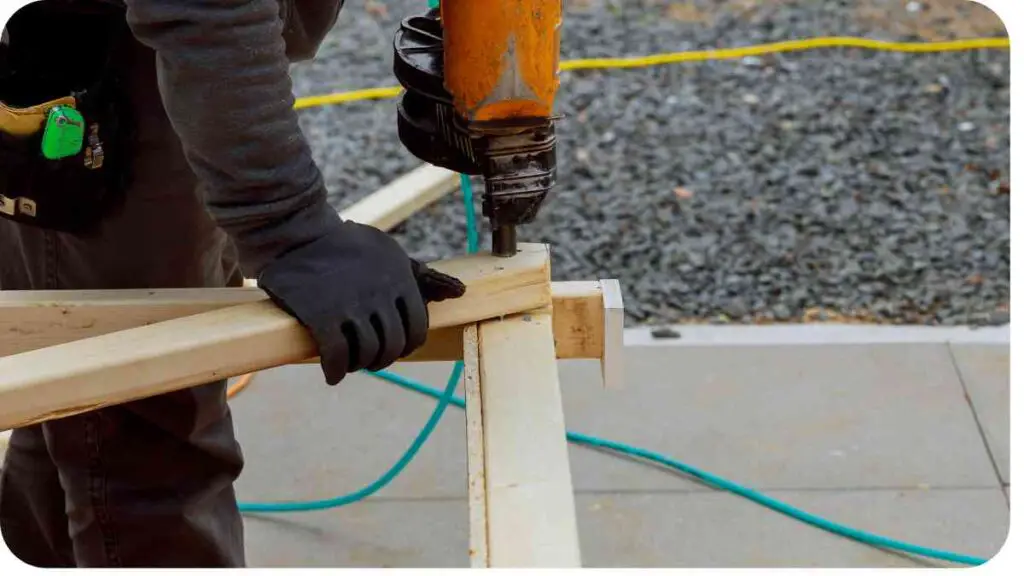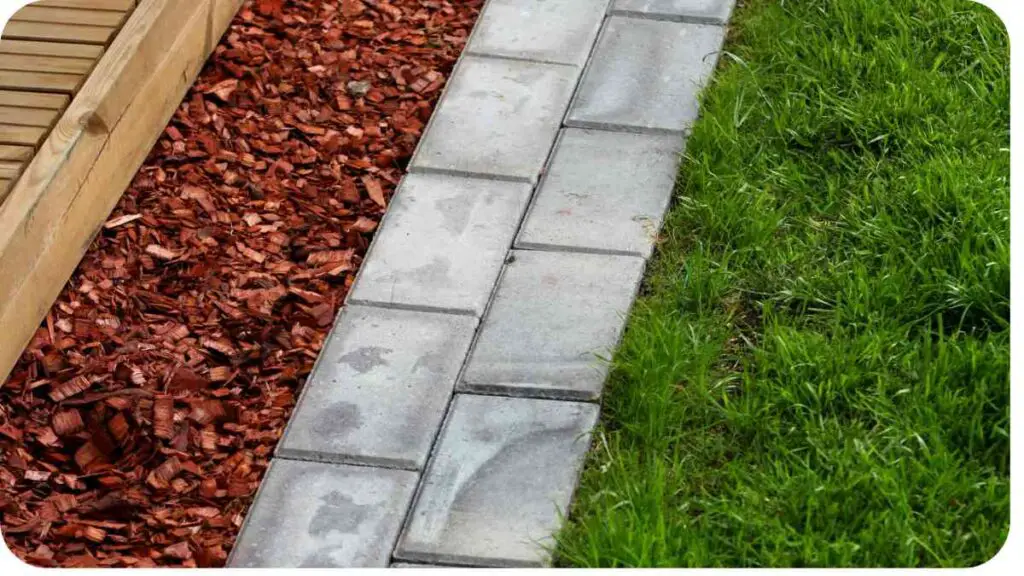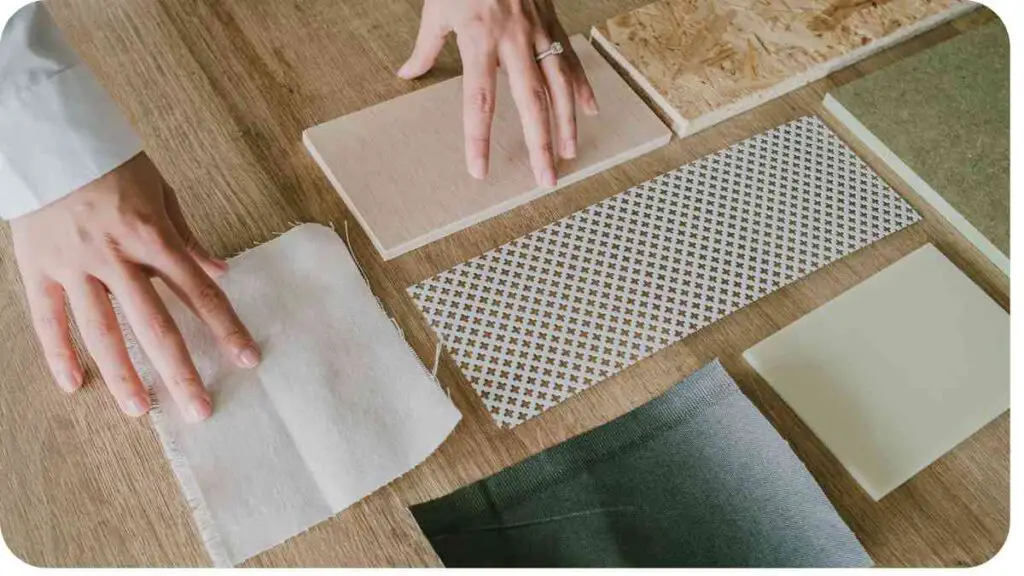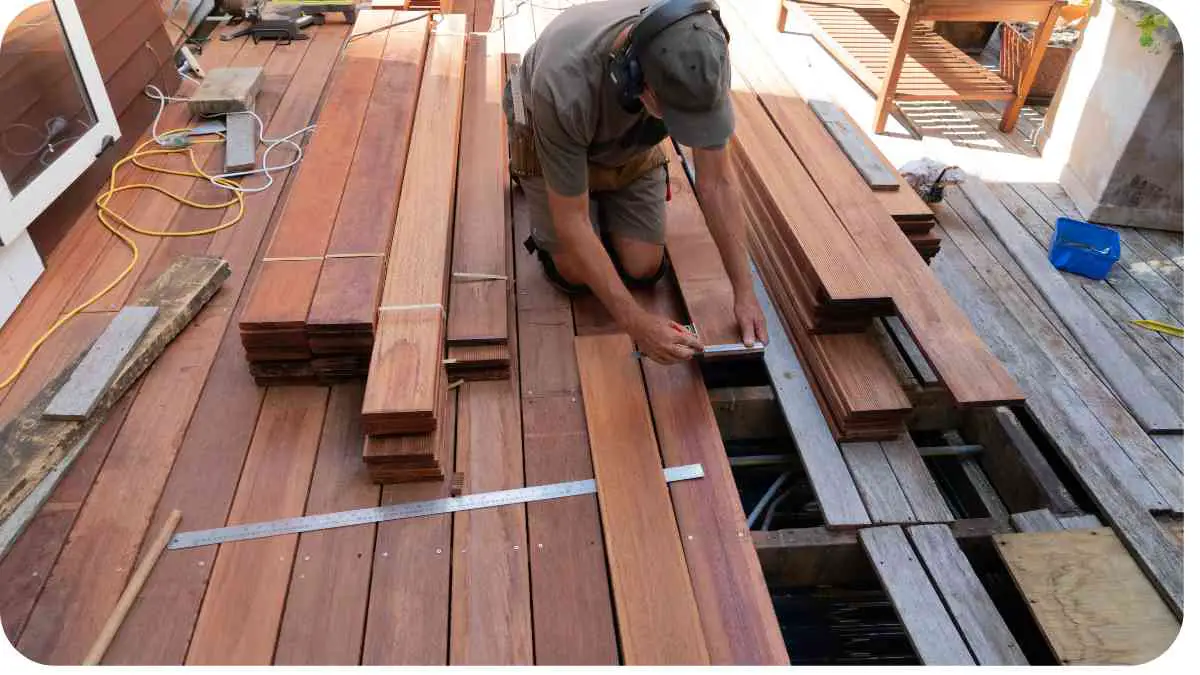When it comes to building or renovating a deck, choosing the right material is crucial for both aesthetics and functionality. With a plethora of options available in the market, it’s essential to understand the characteristics, pros, and cons of each material to make an informed decision. In this guide, we’ll compare three popular deck materials: Natural Wood, Composite, and PVC.
| Key Takeaways |
|---|
| 1. Understand the pros and cons of each deck material. |
| 2. Consider factors such as cost, durability, and maintenance requirements. |
| 3. Choose a deck material that aligns with your budget and lifestyle. |
| 4. Prioritize sustainability and environmental impact when possible. |
| 5. Invest in quality materials and professional installation for long-term satisfaction. |
2. Types of Deck Materials

Natural Wood
| Attribute | Cedar | Pressure-Treated Pine | Redwood |
|---|---|---|---|
| Cost | Moderate | Low to Moderate | High |
| Durability | Moderate | Moderate | High |
| Maintenance | High | High | Moderate |
| Aesthetics | Natural beauty | Prone to Warping | Rich color |
| Environmental | Renewable | Chemical Treatment | Sustainable |
Cedar: Known for its natural beauty and resistance to decay, cedar is a popular choice for decking. However, it requires regular maintenance to preserve its appearance.
Pressure-Treated Pine: Affordable and readily available, pressure-treated pine is treated with chemicals to resist rot and insects. However, it tends to warp and requires frequent maintenance.
Redwood: Offering durability and a rich color, redwood is a premium option for decking. It’s naturally resistant to decay but requires moderate maintenance to retain its appearance.
Enhance your deck with a pergola” Can You Put a Pergola on a Deck? Answered to create a versatile outdoor space perfect for relaxation and entertainment. Discover the feasibility and benefits of adding a pergola to your deck today!
Composite
| Attribute | Trex | TimberTech | Fiberon |
|---|---|---|---|
| Cost | High | Moderate to High | Moderate |
| Durability | High | High | High |
| Maintenance | Low | Low | Low |
| Aesthetics | Wood-like | Varied Colors | Natural |
| Environmental | Recycled | Recycled | Eco-friendly |
Trex: Leading the composite decking industry, Trex offers high durability and low maintenance. It’s made from recycled materials and mimics the look of natural wood.
TimberTech: Known for its wide range of colors and textures, TimberTech decking is highly durable and low maintenance. It’s also made from recycled materials.
Fiberon: Offering eco-friendly decking solutions, Fiberon combines durability with natural aesthetics. It requires minimal maintenance and is made from recycled materials.
PVC
| Attribute | AZEK | Wolf Home Products | Genovations |
|---|---|---|---|
| Cost | High | Moderate to High | Moderate |
| Durability | High | High | High |
| Maintenance | Low | Low | Low |
| Aesthetics | Low maintenance | Variety of Colors | Wood-like |
| Environmental | PVC | PVC | PVC |
AZEK: Renowned for its low-maintenance decking solutions, AZEK offers high durability and a wide variety of colors. It’s made from PVC, ensuring resistance to moisture and insects.
Wolf Home Products: Providing durable and low-maintenance PVC decking options, Wolf Home Products offers a variety of colors and styles to suit any aesthetic preference.
Explore pergola roofing options” Can a Pergola Have a Solid Roof? Explained and elevate your outdoor living experience. Learn about the different types of solid roof options available for pergolas and how they can enhance your outdoor space.
Genovations: Known for its wood-like appearance and high durability, Genovations PVC decking requires minimal maintenance and offers long-lasting performance.
3. Cost Comparison
Choosing the right deck material involves considering not only the initial cost but also long-term expenses such as maintenance and repairs.
Initial Cost
When comparing the initial cost of deck materials, natural wood tends to be more affordable upfront, especially options like pressure-treated pine. Composite and PVC decking typically have a higher initial cost due to their advanced manufacturing processes and durability.
| Deck Material | Initial Cost (per square foot) |
|---|---|
| Cedar | $3 – $7 |
| Pressure-Treated Pine | $2 – $5 |
| Redwood | $5 – $10 |
| Trex | $7 – $12 |
| TimberTech | $6 – $11 |
| Fiberon | $5 – $9 |
| AZEK | $8 – $14 |
| Wolf Home Products | $7 – $13 |
| Genovations | $6 – $10 |
Maintenance Cost
While natural wood may seem cheaper initially, it often requires more frequent maintenance, such as staining and sealing, which can add up over time. On the other hand, composite and PVC decking have lower maintenance costs since they don’t require staining, sealing, or regular upkeep like natural wood.
| Deck Material | Maintenance Cost (annual) |
|---|---|
| Cedar | $300 – $500 |
| Pressure-Treated Pine | $200 – $400 |
| Redwood | $250 – $450 |
| Trex | $50 – $100 |
| TimberTech | $50 – $100 |
| Fiberon | $50 – $100 |
| AZEK | $0 – $50 |
| Wolf Home Products | $0 – $50 |
| Genovations | $0 – $50 |
Lifetime Cost
When considering the lifetime cost of a deck, it’s essential to factor in both the initial investment and ongoing maintenance expenses. While natural wood may have a lower initial cost, the lifetime cost could be higher due to maintenance requirements. Composite and PVC decking, despite their higher upfront cost, often prove to be more cost-effective in the long run due to minimal maintenance requirements.
4. Durability and Longevity
The durability and longevity of a deck material play a significant role in its overall value and lifespan.
Natural Wood
Natural wood decking, such as cedar, pressure-treated pine, and redwood, offers moderate to high durability depending on the species. However, it is prone to rot, decay, and insect damage over time, especially without proper maintenance.
Unlock the secrets of pergola functionality” How Do Pergolas Work? Find Out to optimize your outdoor living area. Learn about the structural design and practical applications of pergolas for creating a stylish and functional space.
Composite
Composite decking, made from a blend of wood fibers and recycled plastic, offers high durability and resistance to rot, decay, and insects. It’s also less prone to warping, cracking, and splintering compared to natural wood.
PVC
PVC decking, composed of polyvinyl chloride, is highly durable and resistant to moisture, rot, insects, and fading. It’s engineered to withstand the elements, making it an ideal choice for long-lasting outdoor decking.
5. Maintenance Requirements

Maintaining your deck is essential to ensure its longevity and aesthetic appeal. Let’s explore the maintenance requirements for different deck materials.
Cleaning
- Natural Wood: Regular cleaning involves sweeping away debris and dirt, followed by washing with a mild soap solution and water. For tougher stains, a deck cleaner may be necessary, followed by rinsing thoroughly.
- Composite: Composite decking can be cleaned with soap and water or a specialized composite deck cleaner. Avoid using harsh chemicals or pressure washers, as they can damage the surface.
- PVC: PVC decking is easy to clean with soap and water. Occasional washing with a mild detergent and water is usually sufficient to maintain its appearance.
Repairs
- Natural Wood: Repairs for natural wood decking may include replacing damaged boards, sanding rough spots, and filling cracks or holes with wood filler. Regular inspections are crucial to identify and address issues promptly.
- Composite: Composite decking typically requires fewer repairs than natural wood. Minor scratches or stains can often be buffed out or spot-treated. In case of significant damage, individual boards can be replaced.
- PVC: PVC decking is highly durable and resistant to damage. Minor scratches or scuffs can be easily repaired with a heat gun or PVC repair kit. For larger damages, replacement may be necessary.
Refinishing
- Natural Wood: Refinishing natural wood decks involves sanding down the surface to remove old finish and applying a new coat of stain or sealant. This process may be required every few years to maintain the wood’s appearance and protection.
- Composite: Composite decking does not require refinishing like natural wood. However, periodic cleaning and inspection are recommended to prevent mold or mildew growth.
- PVC: PVC decking typically does not require refinishing. Its color and finish remain consistent over time with minimal maintenance.
6. Aesthetics and Appearance
The aesthetics of your deck can significantly impact the overall look and feel of your outdoor space. Let’s compare the aesthetics of different deck materials.
Natural Wood
Natural wood decking, such as cedar, pressure-treated pine, and redwood, offers a classic and timeless look. Each wood species has its unique grain patterns and colors, adding warmth and character to the deck.
Composite
Composite decking mimics the appearance of natural wood while offering more uniformity in color and texture. It’s available in a wide range of colors and finishes, allowing homeowners to achieve the look they desire without the maintenance requirements of wood.
PVC
PVC decking often resembles natural wood but with a more consistent appearance and color. It’s available in various finishes and colors, including wood-like textures and tropical hardwoods. PVC decking offers a modern and sleek aesthetic with minimal upkeep.
Ensure compliance with pergola regulations” What Happens If You Build a Pergola Without a Permit? and avoid legal hassles. Gain insights into the consequences of building a pergola without proper permits and regulations to ensure a smooth and trouble-free project.
7. Environmental Impact
Considering the environmental impact of your deck material choice is essential for sustainability and responsible stewardship of natural resources.
Sustainability
- Natural Wood: Opting for sustainably sourced wood, such as cedar from certified forests, promotes responsible forestry practices. However, the depletion of forests and habitat destruction remain concerns.
- Composite: Composite decking utilizes recycled materials, such as wood fibers and plastic, diverting waste from landfills. Additionally, some manufacturers offer eco-friendly options made from renewable resources.
- PVC: PVC decking is not inherently sustainable, as it relies on petroleum-based materials. However, some manufacturers use recycled PVC or implement eco-friendly production processes to reduce environmental impact.
Recycling
- Natural Wood: Wood decking can be recycled or repurposed into mulch, furniture, or other wood products. Proper disposal and recycling practices help minimize waste and promote circularity.
- Composite: Composite decking contains recycled materials and is recyclable at the end of its lifespan. Many manufacturers offer take-back programs to collect and recycle old composite decking boards.
- PVC: PVC decking can be recycled, although the process may be more complex than recycling other materials. Some manufacturers accept PVC decking for recycling or offer recycling programs.
Carbon Footprint
- Natural Wood: The carbon footprint of natural wood decking depends on factors such as transportation, logging practices, and forest management. Sustainable forestry practices can mitigate environmental impact.
- Composite: Composite decking typically has a lower carbon footprint than natural wood due to the use of recycled materials and reduced maintenance requirements. However, the manufacturing process may still involve energy-intensive processes.
- PVC: PVC decking has a relatively low carbon footprint compared to natural wood, as it requires less energy and water during production. However, concerns about PVC’s environmental impact, such as chemical emissions and disposal, remain.
8. Installation Process
Understanding the installation process for different deck materials can help homeowners make informed decisions based on their skill level, time constraints, and budget.
DIY vs Professional Installation
- Natural Wood: While natural wood decking can be installed by DIY enthusiasts, it requires precise measurements, cutting, and fastening techniques. Professional installation ensures proper alignment, support, and finishing.
- Composite: Composite decking is often designed for easy installation, with interlocking boards and hidden fasteners. DIY installation is feasible for homeowners with basic carpentry skills, but professional installation guarantees a professional finish.
- PVC: Similar to composite decking, PVC decking systems are engineered for straightforward installation. DIY installation is possible, but professional contractors can ensure optimal performance and durability.
Time Required
- Natural Wood: The installation time for natural wood decking varies depending on the complexity of the design, size of the deck, and skill level of the installer. On average, it may take several days to complete the installation.
- Composite: Composite decking typically requires less time to install than natural wood due to its ease of handling and hidden fastening systems. The installation process can be completed in a shorter timeframe, reducing labor costs.
- PVC: PVC decking installation is similar to composite decking in terms of speed and ease of installation. Homeowners can expect a quicker installation process compared to natural wood, especially with professional assistance.
Complexity
- Natural Wood: Installing natural wood decking involves intricate detailing, such as cutting boards to size, creating intricate designs, and finishing edges. Complex designs may require advanced carpentry skills and specialized tools.
- Composite: Composite decking simplifies the installation process with uniform board sizes, hidden fasteners, and pre-drilled holes. While complex designs are still achievable, the overall installation is more straightforward compared to natural wood.
- PVC: PVC decking installation is similar to composite decking in terms of simplicity and ease of installation. The straightforward design and interlocking systems streamline the installation process, even for intricate designs.
9. Safety Considerations
Ensuring the safety of your deck is paramount for enjoying outdoor spaces without worry. Let’s explore the safety considerations for different deck materials.
Slip Resistance
- Natural Wood: Natural wood decking can become slippery when wet, especially if not properly maintained. Applying a non-slip coating or using textured finishes can improve traction and reduce the risk of slips and falls.
- Composite: Composite decking typically has better slip resistance than natural wood due to its textured surface and moisture-resistant properties. However, it’s still advisable to keep the surface clean and free of debris to prevent slips.
- PVC: PVC decking often features textured surfaces for improved slip resistance, making it safer for outdoor use, even in wet conditions. Regular cleaning and maintenance help maintain optimal traction.
Fire Resistance
- Natural Wood: Traditional wood decking is combustible and may pose a fire risk, especially in dry conditions or areas prone to wildfires. Applying fire-retardant treatments can enhance fire resistance, but ongoing maintenance is necessary.
- Composite: Composite decking is inherently more fire-resistant than natural wood due to its composition of wood fibers and plastic. However, it’s essential to check the fire rating of specific products and follow safety guidelines.
- PVC: PVC decking has a high ignition point and is considered more fire-resistant than wood decking. It does not readily combust, making it a safer option for outdoor spaces.
Structural Integrity
- Natural Wood: Natural wood decking relies on proper support structures, such as joists and beams, to maintain structural integrity. Regular inspections for signs of rot, decay, or termite damage are essential for ensuring safety.
- Composite: Composite decking is engineered for consistent strength and stability, reducing the risk of structural issues like warping or sagging. However, proper installation and support are still necessary to maintain safety.
- PVC: PVC decking offers excellent structural integrity, with minimal risk of warping, rot, or insect damage. Its lightweight nature and uniform composition contribute to long-term stability and safety.
10. Popular Brands and Manufacturers

Choosing a reputable brand and manufacturer for your deck material ensures quality, reliability, and customer satisfaction. Here are some popular brands in the decking industry:
Natural Wood
- Trex: Known for its high-performance composite decking, Trex offers a range of colors and finishes to suit any aesthetic preference. With innovative technology and sustainability initiatives, Trex is a leading choice for eco-conscious homeowners.
- TimberTech: TimberTech decking combines durability, aesthetics, and low maintenance for outdoor spaces that stand the test of time. With a focus on innovation and design versatility, TimberTech offers solutions for every style and budget.
- Fiberon: Fiberon decking is designed for beauty and performance, with a wide selection of colors and textures to enhance outdoor living spaces. Backed by industry-leading warranties and sustainable practices, Fiberon is a trusted choice for homeowners and contractors alike.
PVC
- AZEK: AZEK decking is engineered for durability, beauty, and sustainability, with low-maintenance solutions for outdoor living. With a commitment to innovation and environmental responsibility, AZEK sets the standard for premium PVC decking.
- Wolf Home Products: Wolf Home Products offers high-quality PVC decking solutions that combine style, durability, and affordability. With a focus on customer satisfaction and product innovation, Wolf Home Products delivers lasting value for homeowners.
- Genovations: Genovations decking features a unique blend of PVC and other materials for unmatched strength, stability, and longevity. With a reputation for innovation and performance, Genovations decking is an excellent choice for discerning homeowners.
11. Conclusion
Choosing the right deck material is a significant decision that can impact the aesthetics, durability, and value of your outdoor living space. By comparing the attributes of natural wood, composite, and PVC decking, homeowners can make informed choices based on their priorities, budget, and lifestyle.
While natural wood offers classic beauty and affordability, it requires regular maintenance to preserve its appearance and structural integrity. Composite decking provides a low-maintenance alternative with excellent durability and aesthetics, making it a popular choice for modern outdoor living.
PVC decking offers superior durability, low maintenance, and a wide range of design options, making it an ideal choice for homeowners seeking long-lasting performance and style. By considering factors such as cost, durability, maintenance requirements, and environmental impact, you can select the deck material that best suits your needs and enhances your outdoor living experience.
Whether you choose natural wood, composite, or PVC decking, investing in quality materials and professional installation ensures a safe, beautiful, and enjoyable outdoor space for years to come. Take your time to research and explore different options, consult with experts, and prioritize your preferences to create the perfect deck for your home.
With the right deck material and proper care, you can create a stunning outdoor oasis where you can relax, entertain, and make lasting memories with family and friends. Here’s to enjoying many years of outdoor living in style and comfort!
Further Reading
- Comparing Deck Options: A Comprehensive Guide to Choosing the Perfect Deck Boards: This blog post provides an in-depth comparison of different deck options, helping homeowners make informed decisions about their decking materials.
- Choosing the Best Deck Material: A Comprehensive Guide: Explore this comprehensive guide to selecting the best deck material for your outdoor space. From natural wood to composite options, this article covers it all.
- Compare Decking Materials: Discover the differences between various decking materials and learn how to choose the right one for your needs. This resource offers valuable insights into the pros and cons of each material.
FAQs
What are the main types of deck materials?
Natural wood, composite, and PVC are the main types of deck materials commonly used for outdoor decking projects.
How do I choose the best deck material for my home?
Consider factors such as cost, durability, maintenance requirements, aesthetics, and environmental impact when choosing the best deck material for your home.
Is natural wood decking more affordable than composite and PVC decking?
Natural wood decking may have a lower initial cost compared to composite and PVC decking, but it often requires more maintenance over time, potentially increasing long-term expenses.
Are composite and PVC decking materials eco-friendly?
Many composite and PVC decking materials are made from recycled materials and are designed to be eco-friendly alternatives to traditional wood decking. However, it’s essential to research the specific sustainability practices of each manufacturer.
Can I install a deck myself, or do I need professional assistance?
While DIY installation is possible for some homeowners, complex projects may require professional assistance to ensure proper installation, structural integrity, and safety.

I am Hellen James, a professional handywoman with expertise in improving home and garden spaces by using pergolas, gazebos, and tents.


